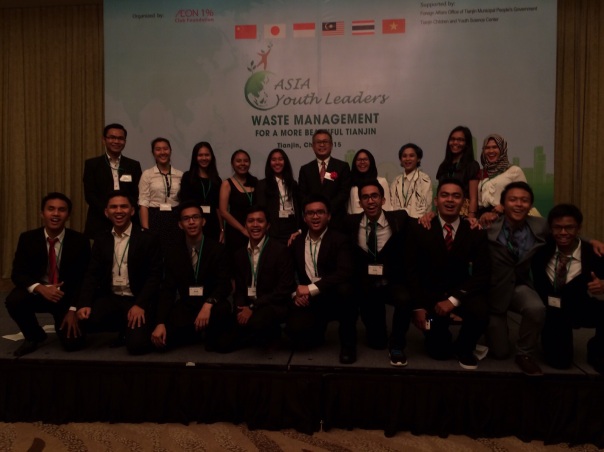Reading time: 7 minutes
I want to share my weeklong experience in Tianjin – China’s 3rd biggest urban city, after Beijing and Shanghai – participating in AEON Asia Youth Leaders 2015. This annual event called out Asia’s top student leaders from Indonesia, Vietnam, China, Japan, Thailand and Malaysia to take part in environmental-based projects throughout the week. This article features 3 valuable lessons I learned from the program. Enjoy!
——————————————————————————————————————————————————————————
Well it was pretty random at first because I never knew about this program. But thankfully for me, I got to know this opportunity by winning The Most Outstanding Student (Mapres) award in Universitas Indonesia in May 2015. As a reward, I could undergo a fast-track selection to get scholarship for AEON Asia Youth Leaders 2015 in Tianjin, China. All I had to do was writing an essay and did a medical check up for health proof. And voila, thank God I’m selected to go! The event itself took place last week from August 16 – 22, 2015. AEON Indonesia sent 5 Mapres winners from my university and 12 top high school students collaborating with Ministry of Education & Culture.
The program featured 5-day lecture, leadership program, group work, site visit, citizen interview, city tour, and presentation when each team should produce campaign/public policy initiative regarding Tianjin waste management. In general, the event was organized very professionally (and very fun too!)
Couple of days before departure, an explosion occurred in Tianjin (see more info here). My family was kinda worried about that, but the organizer explained that everything would be alright cause all the events would take place in the downtown areas, >70 km away from the explosion in port area. So this trip to Tianjin better be something memorable right?
All in all, I feel like sharing these 3 valuable lessons that I got from AEON Asia Youth Leaders 2015 event:
1. “If you come late, I’ll leave you”
I mean, this takeaway might be so classic. Despite Indonesians high tolerance towards bad habit of being late, I myself have been exposed to many international experiences that taught me on how being punctual is the key. However, never in my life I come to an event that 100% of its rundown occurred timely without any delay, not even 1 second. All the program schedules were designed so thoughtfully so that no time lag is allowed. Most importantly, they just didn’t do it by default – they programmed it. We received wake up call in our room every morning, all meeting time and schedules for the next day were always communicated the night before, and they would leave the ones who came late. It wasn’t an empty threat like we do here in Indonesia like “If you come late, I’ll leave you” when in fact it’s almost impossible to do that cause maybe both people will come late for many reasons and in the end tolerate each other’s lateness LOL. During the event, the organizer really left the students who came late so they must take taxi to catch us up to the next venue. In the final day, the organizer was so punctual and didn’t allow participants to enter the room for final presentation if they came late.
In the end, we all enjoyed the beauty of this punctuality. All programs were run smoothly without delay, everyone could get some rests early and no one was waiting like a fool without knowing when the event is gonna be started. It was like a perfect execution. It’s probably attributed to the fact that AEON is Japanese company in which Japanese highly value time discipline. Whatever the reason, it’s like a really hard slap in the face – more than a wakeup call – for myself to start appreciating time and habituate myself to be timely. I cannot allow lag of time in execution and must practice self-discipline to start something remarkable.
2. Management-consulting working style is kinda preferable for big team size
Each team consisted of 10 people coming from all represented countries. It was a bloody hard job to unite different opinions and perspectives. For me, a perfect brainstorming should not exceed 5 people in a group. So dividing a big 10-people group into two smaller 5-people group helped a lot. As a project leader, I learned a lot from this experience on how to structure work and divide tasks when your team was complete strangers that you hadn’t met before. I felt really thankful because I could apply all my consulting skill set in problem solving and work plan to manage the team in producing the deliverables. And on top of everything, listening is always the hardest part. I learned a lot how to listen and let other people talk; something that’s more difficult when the group size is bigger. I think, the mission was accomplished perfectly as our group was crowned as Runner Up!
3. Get connected with fellow Asians is the key!
I mean, I have attended so many conferences in different corners of the world. I have met and befriended with many North Americans, Europeans, Latin Americans, Asians, Australians, Africans, New Zealanders, and even Pacific People. But one thing that I haven’t taken a closer look at is my own neighboring countries – the Asians. I realized it because 100% of the participants in AEON Asia Youth Leaders 2015 are all Asians. I felt like I’m suddenly embraced with a very relatable cultural setting. At first, I felt like I didn’t belong to the group because of the language barrier. I might attribute myself as ESL (English as a Second Language) person, but reality is there are more EFL (English as a Foreign Language) people in Asia than the ESL. That’s why understanding culture – better yet language – is beyond important if one wants to do business in Asia. Each country literally has unique cultural attribute that’s exposed in the way one talks, eats, prays, thinks, communicates, and does things. And it was not something theoretical; I experienced it myself through human interaction. This cultural differences at first made our group discussion slower because many language misinterpretation and miscommunication took place. But that’s Asia, after all. The diverse yet developing people are my family to whom I’m gonna do business with for the next decades. So I have to try understanding them. I realize that I shouldn’t only look up to the West for inspiration or reference cause the the future belongs here in Asia. So, I promise myself to engage with more Asian-based events or business conferences in the future 🙂
Lastly, the city itself was really modern and vibrant – except the crazy pollution of course! Find some of my pics below:
Special thanks to AEON 1% Club Foundation for this extraordinary experience! Also, thanks to Team Indonesia and especially Team G for being a new family to me! Hope to see you all again!









